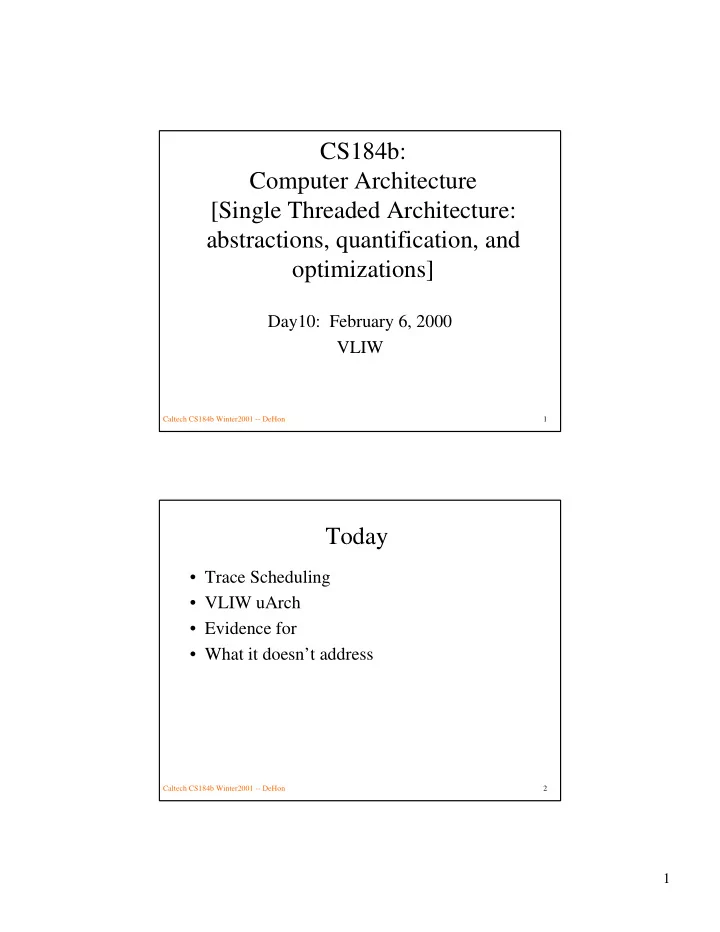

CS184b: Computer Architecture [Single Threaded Architecture: abstractions, quantification, and optimizations] Day10: February 6, 2000 VLIW Caltech CS184b Winter2001 -- DeHon 1 Today • Trace Scheduling • VLIW uArch • Evidence for • What it doesn’t address Caltech CS184b Winter2001 -- DeHon 2 1
Problem • Parallelism in Basic Block is limited – (recall average branch freq. Every 7-8 instrs) Caltech CS184b Winter2001 -- DeHon 3 Solution: Trace Scheduling • Schedule likely sequences of code through branches – instrument code • capture execution frequency / branch probabilities – pick most common path through code – schedule as if that happens – add “patchup” code to handle uncommon case where exit trace – repeat for next most common case until done Caltech CS184b Winter2001 -- DeHon 4 2
Typical Example 0.9 B C C B D D D Caltech CS184b Winter2001 -- DeHon 5 Solution Validity • Recall from Fisher/Predict paper – 50-150 instructions/mispredicted branch Caltech CS184b Winter2001 -- DeHon 6 3
Trace Example • Bulldog Fig 4.2 Bulldog: A Compiler for VLIW Architectures MIT Press 1986 ACM Doctoral Dissertation Award 1985 Caltech CS184b Winter2001 -- DeHon 7 Trace Join Example Bulldog p61 Caltech CS184b Winter2001 -- DeHon 8 4
Trace Join Example Bulldog p61-62 Caltech CS184b Winter2001 -- DeHon 9 Trace Multi-Branch Example Bulldog p69 Caltech CS184b Winter2001 -- DeHon 10 5
Trace Multi-Branch Example Bulldog p69-70 Caltech CS184b Winter2001 -- DeHon 11 Trace Advantage • Avoid fragmentation – can’t fill issue slots because broken by branches • Expose more parallelism – concurrent run things on different sides of branches – allow more global code motion (across branches) Caltech CS184b Winter2001 -- DeHon 12 6
Machine • Single PC/thread of control • Wide instructions • Branching • Register File • Memory Banking Caltech CS184b Winter2001 -- DeHon 13 Branching • Allow multiple branches per “Instruction” – n-way branch • N-tests + 1 fall-through – order in trace order – take first to succeed • Encoding – single base address – branch to base+i • i is test which succeeded Caltech CS184b Winter2001 -- DeHon 14 7
Split Register File • Each cluster has own RF – (register bank) – can have limited read/write bw • Limited networking between clusters – explicit moves between clusters when results needed elsewhere Caltech CS184b Winter2001 -- DeHon 15 Memory Banks • Separate Memory Banks – dispatch set of non-conflicting loads/stores, each to separate memory banks – trick is can compiler determine non-conflict • (do layout o avoid conflicts) – has to know won’t conflict (for VLIW timing) Caltech CS184b Winter2001 -- DeHon 16 8
Memory Banks • Avoid single memory bottleneck • Avoid having to build n-ported memory • Can make likelihood of conflict small • Costs for crossbar between memory and consumers • Arbitration required if can’t staticly schedule access pattern • Hotspots/poor bank allocation can degrade performance Caltech CS184b Winter2001 -- DeHon 17 ELI “Realistic” Bulldog Fig 8.1 Caltech CS184b Winter2001 -- DeHon 18 9
Ellis Results Caltech CS184b Winter2001 -- DeHon Bulldog p242 19 Two CMOS VLIWs • LIFE [ISSCC90] 23 ALU bops/ λ 2 s • VIPER [JSSC93] 9.8 Caltech CS184b Winter2001 -- DeHon 20 10
What can/can’t it do? • Multiple Issue? • Renaming? • Branch prediction? – Static – dynamic • Tolerate variable latency? – Memory – functional units Caltech CS184b Winter2001 -- DeHon 21 Scaling • Issue • Bypass • Register File • N-way branch • Memory Banking • RF-RF datapath Caltech CS184b Winter2001 -- DeHon 22 11
Scaling • Linear Scaling – Issue – Bypass (only within cluster) – Register File (separate per cluster) • Super linear – Memory Banking [ (clusters) 2 ? ] – RF-RF datapath ? • Unclear from small examples (and didn’t study) Caltech CS184b Winter2001 -- DeHon 23 Scaling: N-way branch? • Probably want to scale up branching with clusters (VLIW length) • Use parallel prefix computation – depth goes as log(N) – area can be linear Caltech CS184b Winter2001 -- DeHon 24 12
Scaling: Thoughts • W/ on-chip memory – banks local to clusters (distributed memory) – can schedule operations on clusters close to memory? – Communicate data among clusters (like RF to RF transfers) if need non-local – How much interconnect needed? • What’s the locality of data communication? • Recall interconnect richness study from last term Caltech CS184b Winter2001 -- DeHon 25 “Weaknesses” • Binary Compatiblity – lack thereof • No “Architecture” • Exceptions Caltech CS184b Winter2001 -- DeHon 26 13
Next Time • EPIC – next generation VLIW evolution Caltech CS184b Winter2001 -- DeHon 27 Big Ideas • Get better packing/performance scheduling large blocks • Common case • Feedback – (future like past) – discover common case • Binding Time hoisting – Don’t do at runtime what you can do at compile time • Stable abstraction Caltech CS184b Winter2001 -- DeHon 28 14
Recommend
More recommend